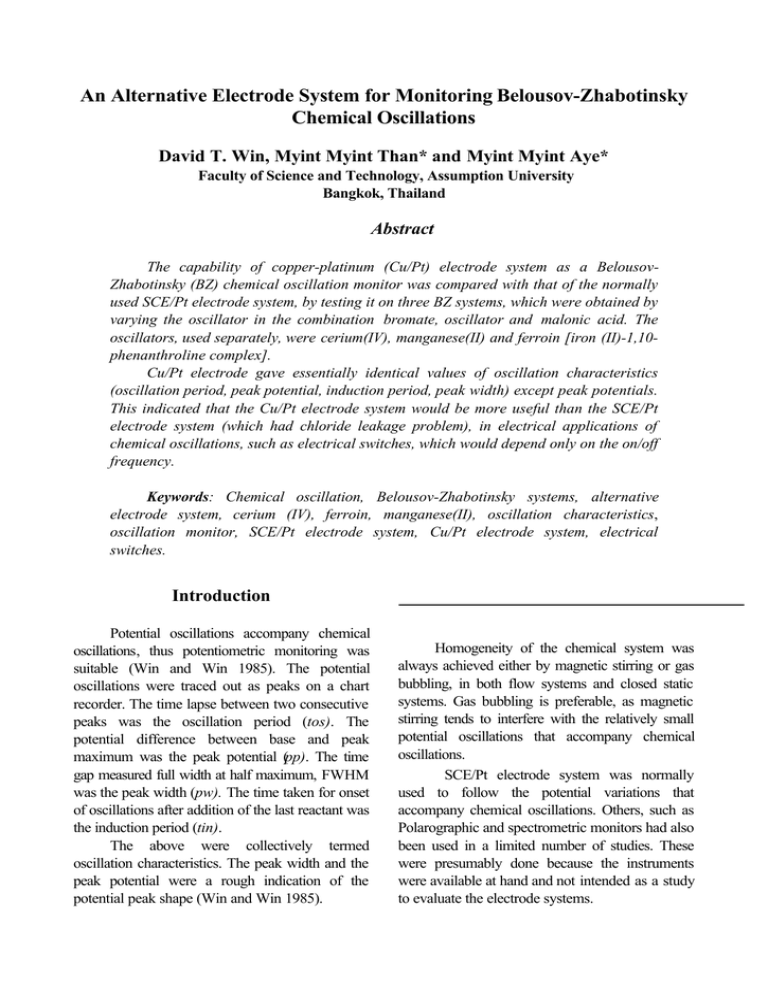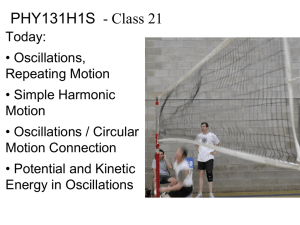An Alternative Electrode System for Monitoring
advertisement

An Alternative Electrode System for Monitoring Belousov-Zhabotinsky Chemical Oscillations David T. Win, Myint Myint Than* and Myint Myint Aye* Faculty of Science and Technology, Assumption University Bangkok, Thailand Abstract The capability of copper-platinum (Cu/Pt) electrode system as a BelousovZhabotinsky (BZ) chemical oscillation monitor was compared with that of the normally used SCE/Pt electrode system, by testing it on three BZ systems, which were obtained by varying the oscillator in the combination bromate, oscillator and malonic acid. The oscillators, used separately, were cerium(IV), manganese(II) and ferroin [iron (II)-1,10phenanthroline complex]. Cu/Pt electrode gave essentially identical values of oscillation characteristics (oscillation period, peak potential, induction period, peak width) except peak potentials. This indicated that the Cu/Pt electrode system would be more useful than the SCE/Pt electrode system (which had chloride leakage problem), in electrical applications of chemical oscillations, such as electrical switches, which would depend only on the on/off frequency. Keywords: Chemical oscillation, Belousov-Zhabotinsky systems, alternative electrode system, cerium (IV), ferroin, manganese(II), oscillation characteristics, oscillation monitor, SCE/Pt electrode system, Cu/Pt electrode system, electrical switches. Introduction Potential oscillations accompany chemical oscillations, thus potentiometric monitoring was suitable (Win and Win 1985). The potential oscillations were traced out as peaks on a chart recorder. The time lapse between two consecutive peaks was the oscillation period (tos). The potential difference between base and peak maximum was the peak potential (pp). The time gap measured full width at half maximum, FWHM was the peak width (pw). The time taken for onset of oscillations after addition of the last reactant was the induction period (tin). The above were collectively termed oscillation characteristics. The peak width and the peak potential were a rough indication of the potential peak shape (Win and Win 1985). Homogeneity of the chemical system was always achieved either by magnetic stirring or gas bubbling, in both flow systems and closed static systems. Gas bubbling is preferable, as magnetic stirring tends to interfere with the relatively small potential oscillations that accompany chemical oscillations. SCE/Pt electrode system was normally used to follow the potential variations that accompany chemical oscillations. Others, such as Polarographic and spectrometric monitors had also been used in a limited number of studies. These were presumably done because the instruments were available at hand and not intended as a study to evaluate the electrode systems. Current interest in the BelousovZhabotinsky chemical oscillations was apparent in the varied publications on different aspects of the topic, such as interest in the phenomena (Hudson and Mankin 1981); interest in three dimensional models (Field and Gyoergi 1991, 1992); publication of books (Epstein and Pojman 2000); theoretical calculations (Martin, 2001), and practical observations (Olexova et al. 1996) and two previous papers by the same authors (Than et al. 2001a,b). In future, chemical oscillations could be developed as electro-chemical switches, which switches electric current flow on and off periodically at a fixed frequency. The normally used SCE/Pt electrode system tends to leak out chloride anions. This would interfere with the bromate functions in chemical oscillations and affect the switching frequency. Thus search for electrode systems for use as monitors in these switches was considered. It was decided to test the Cu/Pt system, which if effective would be free from leakage problem and would be much cheaper (Win and Win 1985). Experimental Potassium bromate, malonic acid, manganese (II) sulfate (VI), iron (II) sulfate (VI), ammonium cerium (IV) sulfate, 1.5 M sulfuric (VI) acid and 1,10-phenanthroline were of reagent grade (BDH) and used without further purification. Standard solutions of various reagents were prepared by dissolving accurately weighed amounts of the above chemicals in exactly measured volumes of 1.5 M sulfuric (VI) acid, except for ferroin solutions which were prepared with deionized water. A Corning pH meter was used in conjunction with platinum Pt, copper Cu and standard calomel SCE electrodes. A waterjacketed glass reactor cell was placed in a temperature-controlled thermostated water bath. The reactants were placed in separate glass vessels and placed in the above water bath to obtain the equilibrium temperature. 20.00 mL potassium bromate solution was introduced into the reactor cell and SCE/Cu or SCE/Pt electrode pair was used. Nitrogen gas was bubbled through at a fixed rate of 25 mL per minute. This was followed by introduction of 20.00 mL malonic acid solution and 10.00 mL of oscillator solution. The stop-clock was started simultaneously. The potential out-put variations were recorded on a UV 365 chart recorder. Three oscillators, cerium (IV), manganese (II) and ferroin [iron (II) - 1, 10-phenanthroline complex] were used separately in three different Belousov - Zhabotinsky chemical oscillation systems. Two electrode configurations were used. The first termed “separate configuration” had Cu or SCE dipped in potassium nitrate KNO3 solution and Pt dipped in the test solution, where chemical oscillations take place. These two solutions were electrically connected via a salt bridge. The second termed “combined configuration” had Cu or SCE and Pt, both immersed in the test solution. The Pt electrode was connected to the “indicator” terminal and Cu or SCE was connected to the “reference” terminal of the Corning pH meter. Additional experiments were done. Tables 4, 5 and 6 showed the results of monitoring the chemical oscillations produced at varying malonic acid levels, in the three chemical oscillation systems, using SCE / Pt and Cu / Pt electrode systems. These results had the same trend as the previous results mentioned above. However, it was observed that oscillations were stopped at high bromate ion concentration when using Cu / Pt in the combined configuration. Bromine gas evolution was seen. This indicated copper interference of bromate functions. This would therefore set the bromate limit for Cu/Pt. Conclusion The Cu/Pt electrode system could be safely used in place of the more costly SCE/Pt electrode provided the bromate level was not too high. Hence Cu/Pt electrode with nitrogen gas bubbling would be most suitable for investigations aimed at electrical applications of chemical oscillations. Acknowledgement Results and Discussion Tables 1, 2 and 3 show the results of monitoring the chemical oscillations produced at varying bromate levels, in the three chemical oscillation systems, using SCE / Pt and Cu / Pt electrode systems. The results obtained by using SCE/Pt, Cu/Pt were essentially identical for oscillation period and peak shape; but the Cu/Pt peak potentials were slightly lower. The lower peak potentials given by Cu/Pt mean that the electrode was not giving the correct potential readout. However it must be pointed out that it was not the peak potential that was of interest but the oscillation period that was of primary interest if application as electrical switches was intended. Hence these initial experiments indicated that Cu/Pt might be used in place of SCE/Pt. The authors are grateful to the Chemistry Department, Yangon University, Myanmar, for providing research facilities and to Assumption University, Thailand, for providing publishing opportunities. References Field, R.J.; and Gyoergi, L. 1991. Simple Models of Deterministic Chaos in Belousov Zhabotinsky Reaction. J. Phys. Chem. 95: 6594-602. Field, R.J.; and Gyoergi, L. 1992. A threevariable model of deterministic chaos in the Belousov - Zhabotinsky reaction. Letters to Nature 355: 808-10. Epstein, I.R.; and Pojman, J.A. 2000. An introduction to nonlinear chemical dynamics: Oscillations, waves, patterns, and chaos. J. Chem. Educ. 77: 450. Hudson, J.L.; and Mankin, J.C. 1981. Chaos in the Belousov-Zhabotinkii reaction. J. Chem. Phys. 74: 6171-7. Martin, S.T. 2001. Employing Complex Kinetic Diagrams. Math. J. 8: 1-20. Olexova, A.; Melichercik, M.; and Treindl, L. 1996. Permanganate Chemical Oscillators with Cyclic Diketones. Collection of Czechoslovak Chemical Communications. Abstracts: 1996, 61 (1), 70-76; doi: 10.1135/ cccc 19960070. Dept. of Physical Chemistry, Comenius Univ., Bratislava, Slovak Rep. Than, M..M.; Aye, M.M.; and Win, D.T. 2001a. Concentration limits for chemical oscillations . AU J.T. 5: 9-12. Than, M.M.; Aye, M.M.; and Win, D.T. 2001b. A potential model for chemical oscillations. AU J.T. 5: 87-91. Win, D.T.; and Win, S. 1985. Chemical Oscillations. CRT Project Report I. Univ. of New South Wales, Sydney, Australia. Table 1. Oscillation Characteristics in BrO 3- - Ce4+- MA system at varying [ BrO 3- ] [KBrO3]/M SCE/Pt Cu/Pt Sep. tin/s tos/s pp/mV tin/s 0.002 780 286 101 0.02 540 74 0.06 695 0.1 0.14 Cu/Pt Comb. tos/s pp/mV tin/s tos/s pp/mV 664 267 109 812 280 110 77 556 68 64 508 65 65 46 54 743 44 45 785 47 48 883 40 46 924 40 35 969 41 33 1125 33 34 1140 34 22 na na na 0.18 1577 28 14 1567 29 9 na na na MA = malonic acid na = data not available; bromine gas evolution (see text) Cu/Pt Sep. = Separated configuration (see text) Cu/Pt Comb. = Combined configuration (see text) Table 2. Oscillation Characteristics in BrO 3- - Mn2+- MA system at varying [ BrO 3- ] [KBrO3]/M SCE/Pt Cu/Pt Sep. Cu/Pt Comb. tin/s tos/s pp/mV tin/s tos/s pp/mV tin/s tos/s pp/mV 0.006 232 81 46 226 81 51 266 80 54 0.02 264 84 45 258 35 45 298 36 47 0.06 344 22 43 345 23 39 385 23 40 0.1 395 20 35 395 20 29 435 20 30 0.14 445 18 20 442 18 23 na na na 0.18 509 16 17 517 17 19 na na na 0.22 590 15 16 560 16 12 na na na MA = malonic acid na = data not available; bromine gas evolution (see text) Cu/Pt Sep. = Separated configuration (see text) Cu/Pt Comb. = Combined configuration (see text) Table 3. Oscillation Characteristics in BrO 3- - Ferroin - MA system at varying [ BrO 3- ] [KBrO3]/M SCE/Pt Cu/Pt Sep. Cu/Pt Comb. tin/s tos/s pp/mV tin/s tos/s pp/mV tin/s tos/s pp/mV 0.01 280 50 34 272 40 44 na na na 0.015 320 27 13 314 25 14 374 25 10 0.02 340 12 8 334 10 7 394 10 5 0.025 380 8 6 369 7 5 429 7 3 0.03 440 7 4 439 6 3 na na na MA = malonic acid na = data not available; bromine gas evolution (see text) Cu/Pt Sep. = Separated configuration (see text) Cu/Pt Comb. = Combined configuration (see text) Table 4. Oscillation Characteristics in BrO 3- - Ce4+ - MA system at varying [ MA ] [MA]/M SCE/Pt Cu/Pt Sep. Cu/Pt Comb. tin/s tos/s pp/mV tin/s tos/s pp/mV tin/s tos/s pp/mV 0.03 883 40 46 924 40 35 969 41 33 0.2 360 13 55 396 14 43 401 14 44 0.8 880 6 36 452 6 28 455 6 29 1.2 490 5 21 538 5 18 540 5 20 1.6 715 4 8 750 4 6 750 4 7 MA = malonic acid na = data not available; bromine gas evolution (see text) Cu/Pt Sep. = Separated configuration (see text) Cu/Pt Comb. = Combined configuration (see text) Table 5. Oscillation Characteristics in BrO 3- - Mn2+- MA system at varying [ MA ] [MA]/M SCE/Pt Cu/Pt Sep. Cu/Pt Comb. tin/s tos/s pp/mV tin/s tos/s pp/mV tin/s tos/s pp/mV 0.01 702 33 10 722 36 16 na na na 0.2 173 11 40 172 12 38 187 12 39 2 90 6 28 98 6 27 113 6 30 4 80 4 23 76 4 15 90 4 14 MA = malonic acid na = data not available; bromine gas evolution (see text) Cu/Pt Sep. = Separated configuration (see text) Cu/Pt Comb. = Combined configuration (see text) Table 6. Oscillation Characteristics in BrO 3- - Ferroin - MA system at varying [ MA] [MA]/M SCE/Pt Cu/Pt Sep. Cu/Pt Comb. tin/s tos/s pp/mV tin/s tos/s pp/mV tin/s tos/s pp/mV 0.01 260 70 18 220 89 17 552 118 25 0.05 330 34 11 305 32 10 467 30 11 0.1 445 30 8 500 30 8 662 28 9 MA = malonic acid Cu/Pt Sep. = Separated configuration (see text) na = data not available; bromine gas evolution (see text) Cu/Pt Comb. = Combined configuration (see text)




